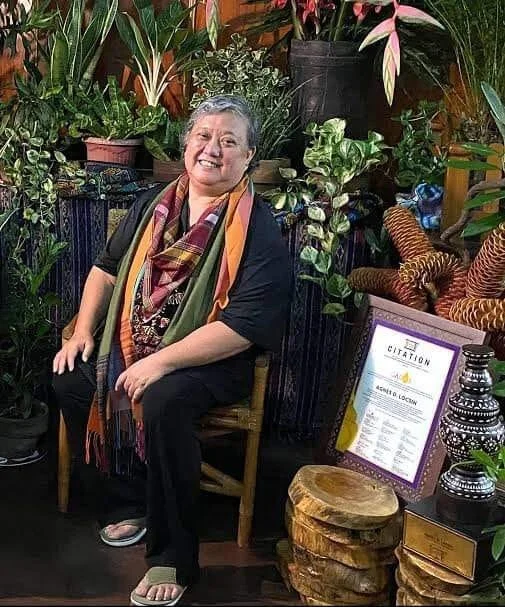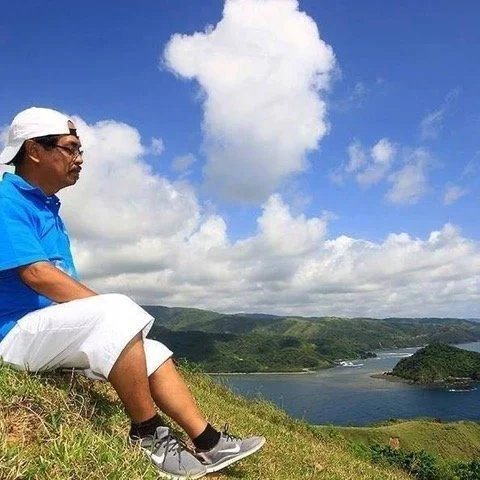Poetry In Motion

Agnes Locsin honored as dance mentor in Davao. Photo by Annie Sartorio)
She was conferred the National Artist Award for her works and achievement in the field of dance, which spurred a growing interest in neo-ethnic style among young artists.
To be sure, it wasn’t an easy life.
In between her choreographing life, Locsin had bouts with cancer, which she conquered with courage and sheer belief in the power of her art.
She was determined to chronicle her choreographic life through a book (Neo-Ethnic Choreography: The Creative Process). She finished it with the help of friends and by sheer determination. “It was difficult since in the first place, I am not much of a writer. I didn’t write the book like chapter by chapter. Chapters three and nine were recollections of how I choreographed my neo-ethnic works. Writing these chapters was fast. Chapter one, which dwelt on Ten Steps to Choreography went slower, but I was guided by what I gave a former student when he asked for tips on how to choreograph. Good thing I remembered them all. Then I hit a wall. In less than a year, I wrote Chapters 1 and 3-9 then I had a writer’s block. Hindi pa ako writer, nag-writer’s block na ako (I wasn’t a writer yet, but I already had writer’s block).”
By Locsin’s own account, her unfinished manuscript slept on the shelf for four years. The UP Press rejected it at first reading. “Of course, I was depressed. But more friends encouraged me not to give up. Writer friends encouraged me to continue and finish the book. After some editing, the book was published in 2012 by UST Press.” It was well-received and was reprinted in 2015.
Of course, she was happy when she was informed of her new title as National Artist for Dance. “I cheered for myself knowing I’d be getting an allowance for the rest of my life! It also occurred to me that I will have something to produce my independent small shows in Davao.”
There were some self-doubts. “Do I really deserve this award? After all I only did what I loved to do which is choreograph. Then the requests for interviews and personal appearances came.”
Locsin realized her title was for real.

Agnes Locsin with fellow National Artist for Dance Alice Reyes in rehearsal.
Before the good news, she was busy with her activities in the Locsin Dance Workshop (LDW), which she almost closed during the first few months of the pandemic.
As with the rest of the creative community, she started offering Zoom classes. The workshop’s annual recitals, summer showcases, and Christmas programs also went virtual. Former dancers based here and abroad participated. Some works included Batali in 2020, Dasal Ni Padre Pio in 2021 and Taghoy Ng Agila in 2022.
And to make up for loss of income, Locsin opened Gigi’s Kitchen, selling food made from her mother’s recipes.
Recalling her early dance life, she admitted it was her mother -- Carmen Dakudao Locsin-- who opened for her a life in dance. Her mother was a ballet teacher and founded the Locsin Dance Workshop in 1947.
From her mother’s account, she started dancing at little over age two with dance classes held in the family living room.
At age 13, Locsin thought of choreographing for her high school classmates and friends. She never stopped. In college, she choreographed for LDW recitals and assorted commissioned dance projects, which included dances for debuts, company, and school competitions, among others.
It was different when Locsin’s works moved on to bigger stages, like the CCP main theater.
She and constant creative partner Joey Ayala consider themselves lucky to have spent their formative years in Davao. “It was in Manila that the challenges, the pressure, and the stress came.”
For the world premiere of her work Encantada, the stress was too much she threw up every morning before opening night. “By the second half of Act 2, I ran out of ideas and images that I would press my head against the wall, hoping to squeeze out any ideas.”
In her recollection, ideas came from so many weird visuals and memories.
She was compensated with a standing ovation on opening night.
With her La Revolucion Filipina, she mixed voice and movements. Actor Nonie Buencamino as Aguinaldo used the spoken word while dancer Alden Lugnasin as Mabini moved to Nonie’s voice. “That was quite a challenge mixing company dancers, BP2 dancers and theater actors together in the choreography. Another headache: developing the libretto because beside the actors, the dancers looked mute. Lines were added and dancers were taught to deliver lines.”
It was unforgettable. She watched La Revolucion Filipina on opening night with tears in her eyes.
For a while, Locsin was artistic director of Ballet Philippines and saw firsthand how dancers live, love, and suffer. “Dancers are vain and insecure. Vain, yes, after all they keep looking at the mirror the whole day. Insecure because they need to be constantly reassured that they are good at what they do.”
Being artistic director was not easy at all. But she survived with artistic director Cecile Manikan as executive director. “She was ruthless and very adept at raising funds. The staff knew that I was first and foremost a choreographer. So they left me alone when I was mounting a new full-length dance narrative.”
Locsin was elated when she finally had to go to Malacanang for the honors.
She has been there twice.
The first time was when she won the silver medal in the Tokyo International Choreography Competition in 1993 and she shook hands with the late President Fidel V. Ramos.
This time her Davao town-mate President Duterte conferred on her the title of National Artist. “Although we are both from Davao, we’ve never really met. It was a thrill really. Even more meaningful and lighthearted was when Digong (President Duterte) congratulated me and said in Visaya, ‘Adlaw-adlaw gud ko nag-agi sa inyong balay katong ga-eskwela pa ko. Wala lang ko nag-enrol kay di man ko kabalo magsayaw.’ (As a student, I’d pass by your house every day on my way to school. I never enrolled because I really can’t dance.)”

Agnes Locsin honored as National Artist for Dance at the CCP main theater. (CCP Photo)

President Duterte giving medallion to National Artist for Dance Agnes Locsin in Malacañang. (Malacañang Photo)
She sizes up her choreographer’s life thus: “Everything was interesting because I kept evolving as a choreographer. I always aimed to make the next choreography as good as or better than the last one. Sometimes I failed, sometimes I did better.
“I used to be so prolific as a choreographer. Fast and furious was how I tackled my projects. When I felt myself slowing down and getting less able to move or make new movements because of my thyroid and cancer problems, I started collaborating with other dancers and choreographers. During the pandemic, I was lucky that Alden Lugnasin and Biag Gaongen were locked down with me here in Davao. They were the reason I was so productive during the pandemic.
“In 2010 to 2019, I collaborated with my former dancers in putting together my Alay Sa Puno series. They were Biag, Georgette Sanchez-Vargas, Gaye Galiluyo, Sonny Locsin, Kris-Belle Paclibar M., and Jojo Mamangun. In re-staging my works in Manila I relied on Annette Mariano, Judell Sicam, and Alden Lugnasin to re-stage as I could only come to Manila every so often.”
In one Davao outreach concert, I met the future National Artist for Dance watch a Cecile Licad recital at the Marco Polo Hotel.
“Watching and listening to Cecile Licad was unforgettable, uplifting, and inspiring. That was the first time I watched her perform. Every time she had a concert at the CCP, I would be in the basement rehearsing. Finally seeing and hearing her was a thrilling experience for me. I remembered she played Chopiniana, as we called the music for ballets. I was so amazed at the passion that poured out of her being into her fingers as they pressed the piano keys. I never thought Chopin music could be passionate! I learned from her performance that one must listen with one’s heart and express movement with one’s heart no matter what the music is.”

Pablo A. Tariman contributes to the Philippine Daily Inquirer, Philippine Star, Vera Files and The Diarist.Ph. He is author of a first book of poetry, Love, Life and Loss – Poems During the Pandemic. He was one of 160 Asian poets who made it in the anthology, The Best Asian Poetry 2021-22 published in Singapore. Born in Baras, Catanduanes, he has three daughters and six grandchildren.
More articles from Pablo A. Tariman






No comments:
Post a Comment